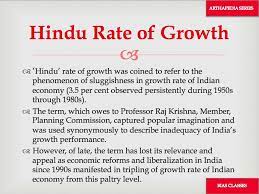
HINDU GROWTH RATE
HINDU GROWTH RATE I RACE IAS : Best IAS Coaching in Lucknow I Current Affairs
Mains Exam: General Studies-3
(Issues and Challenges related to Indian Economy)
Context:
- Recently, former Governor of Reserve Bank of India and economist RaghuramRajan has expressed his concern in the context of India's low economic growth rate.
Main points:
- RaghuramRajan said India is dangerously close to the Hindu rate of growth due to weak private sector investment, high interest rates and slow global growth.
- Rajan said the latest estimates of national income, released by the National Statistics Office (NSO) last month, show that the sequential deceleration in quarterly growth is a matter of concern.
- Figures show that the GDP growth in the third quarter of the current financial year has declined to 4.4 per cent from 6.3 per cent in the second quarter and 13.2 per cent in the first quarter. Whereas, the growth rate in the third quarter of the last financial year was 5.2 per cent.
- RaghuramRajan said that I am worried about the sequential slowdown. RBI is still raising the growth rates while global growth is expected to ease towards the end of the year. He said, the biggest question is what will be the Indian growth rate in the financial year 2023-24. Even if this growth rate remains at five per cent next year, it will be a good thing for India.
- He said that all the developmental works done by the government have not yielded any benefit so far.
- Recently Chief Economic Advisor V.AnanthNageswaran attributed the slow quarterly growth to the upward revision of estimates of national income for previous years.
What is Hindu Growth Rate:
- The low growth rate of Indian economy from 1950 to 1980 is called Hindu growth rate.
- Hindu growth rate is a term describing the low Indian economic growth rate from the 1950s to the 1980s.
- The term was coined by Raj Krishna, an Indian economist in the year 1978 to describe the slow growth rate.
- Here this word has nothing to do with Hindu religion. Actually, 'Hindu rate of growth' is a theory of economics. This term is often used in economic forums. The matter is after independence. When the country became independent in the year 1947, the economic condition of India was not strong at that time. Most of the people were dependent on agriculture. There was severe poverty in the society. There was only railway in the name of infrastructure. There was a lack of roads. But slowly these things started being manufactured in the country. That's why the country's growth rate remained very low for three decades (1950 to 1980) after independence. The average annual economic growth rate of the country during this period was just around 3.5 per cent. Renowned economist Professor Raj Krishna named this slow growth rate as 'Hindu Rate of Growth' in 1978. Since then this word is being used in the economic world.
When did India's Growth Rate increase:
- In 1991, the era of economic reform started in India. Narasimha Rao's government started liberalisation. Since then the country's growth rate increased rapidly leaving the slow pace of 'Hindu rate of growth'. Especially between the years 2003 and 2008, the country's growth rate was around 9 percent on an average.
How is the Growth Rate estimated:
- Gross Domestic Product (GDP) at the country level and Gross State Domestic Product (GSDP) at the state level are taken as the basis.
- Under this basically production in industry and agriculture sector is seen.
- When compared to the previous year, the increase in production is seen as growth rate. For example, if a state produces Rs 100 in one year and Rs 110 in the next year, then it is considered as a growth rate of 10 percent.
- Negative (negative-minus) growth rate is also counted when production is low. For example, production of Rs.80 as compared to Rs.100 is called a minus growth rate of 20 percent.
Measures to increase the Economic Growth Rate:
- Agriculture should be given priority to increase the growth rate. Although the share of agriculture in the country's GDP at the time of independence was about 50 per cent, it has come down to 14 per cent now. Nevertheless, the decline in agricultural production definitely affects the growth rate.
- One of the biggest challenges facing the Indian economy is the challenge of job creation. A holistic approach should be adopted to solve this problem.
- There is a need to change the rules and provisions of the current education sector in line with international standards.
- The role of digitization in the education sector should be increased.
- Public sector banks should be very careful in lending to private companies so that credit growth can increase.
- In order to strengthen India's economy, the central government should promote private investment along with the stimulus package.
- Manufacturing sector needs to be encouraged for higher growth rate.
Conclusion:
- At present, the continuous decrease in the growth rate can be a cause of concern for the country.
- Due to the low growth rate, not only the export of manufactured goods in the country starts decreasing, but the country's credit at the international level also starts getting negatively affected.
- Therefore, in order to deal with the serious challenges related to economic development, the government should strengthen the economy at the domestic level.
--------------------------------------------------
Mains Exam Question:
What is Hindu growth rate? Discuss the challenges and their solutions related to the rate of economic growth.